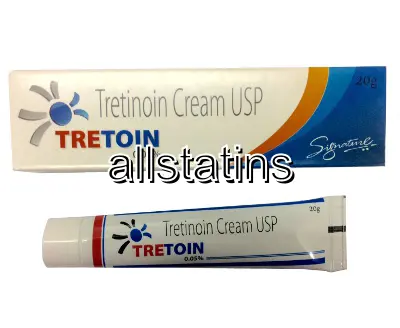Buy Tretinoin Online in the USA at All Statins
| Package | Dosage | Price | Price per Dose | |
|---|---|---|---|---|
| Dosage: 0.1% | ||||
| 5 tube | 0.1% | $179.38 | $35.88 | |
| 4 tube | 0.1% | $157.85 | $39.47 | |
| 3 tube | 0.1% | $139.91 | $46.64 | |
| 2 tube | 0.1% | $104.03 | $52.03 | |
| 1 tube | 0.1% | $62.77 | $62.77 | |

Tretinoin Description
Overview of Tretinoin
Tretinoin, also known as all-trans retinoic acid, is a derivative of Vitamin A that has been widely used in dermatology for its powerful effects on skin renewal. It is primarily prescribed to treat acne vulgaris and has also shown benefits in reducing the appearance of fine lines, improving skin texture, and managing certain types of skin discoloration. As an influential topical medication, Tretinoin stimulates cellular turnover, helping the skin shed old, dead cells and generate fresh, healthier skin.
Mechanism of Action
This medication works by binding to retinoic acid receptors in skin cells, which influences gene expression. It encourages the shedding of dead skin cells and increases collagen production. These actions lead to clearer, smoother skin and help prevent pore blockages that cause acne. Over time, continuous use can significantly improve the overall appearance of the skin, giving it a brighter and more even tone.
Application and Usage
Tretinoin is usually supplied in cream or gel form. It is important to follow the prescribed instructions carefully. Typically, users are advised to apply a thin layer of the medication on clean, dry skin once daily, usually in the evening. Due to its potency, initial side effects such as dryness, redness, and peeling are common. To minimize irritation, it is recommended to start with a lower concentration and gradually increase usage as tolerated. Sunscreen use during daytime is essential, as Tretinoin can increase skin sensitivity to UV rays.
Benefits of Tretinoin
The key benefits of Tretinoin include effective treatment for persistent acne. Many users report significant improvements after consistent use over several weeks. Beyond acne, Tretinoin helps reduce the appearance of fine lines, wrinkles, and age spots. It can also improve skin texture, making the skin look smoother and more youthful. Because of these advantages, it remains one of the most trusted options in anti-aging and acne therapies.
Potential Side Effects
While Tretinoin is highly effective, it may cause side effects, especially at the beginning of treatment. Common issues include skin dryness, irritation, burning sensation, itching, and peeling. These effects are generally temporary and diminish with continued use. However, some users may experience more severe reactions, such as blistering or excessive redness, which require medical attention. It is important to consult with a healthcare professional before starting treatment and to report any adverse effects.
Precautions and Considerations
People with sensitive skin should approach Tretinoin cautiously. Pregnant and breastfeeding women are usually advised to avoid using it due to potential risks to the fetus or infant. Individuals with eczema or rosacea should seek medical advice before starting therapy. Use of other skincare products containing alpha hydroxy acids, benzoyl peroxide, or salicylic acid should be minimized to reduce irritation. Regular use of broad-spectrum sunscreen and protective clothing is crucial during sunlight exposure.
Final Thoughts
Tretinoin remains a cornerstone in dermatological treatments for acne and skin rejuvenation. Its ability to promote cellular turnover makes it a versatile medication for improving skin health. Despite potential side effects, when used correctly under medical supervision, it can offer significant cosmetic and dermatological benefits. Patience and consistent application are key to achieving the best results with this powerful retinoid.
See Also


